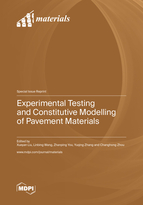Experimental Testing and Constitutive Modelling of Pavement Materials
A special issue of Materials (ISSN 1996-1944). This special issue belongs to the section "Construction and Building Materials".
Deadline for manuscript submissions: closed (10 February 2023) | Viewed by 38918
Special Issue Editors
Interests: • Mechanics of multiphase media • Experimental testing and constitutive modelling of pavement materials • Pavement analysis & design • Multi-physics flow and damage phenomena in asphalt mixtures • Non-linear finite element analysis techniques • Experimental testing and constitutive modelling of structural interlayer systems • Experimental testing and computational characterization of multilayer asphalt surfacing systems on orthotropic steel deck bridges • Multi-scale constitutive modelling of asphalt concrete • Induction healing technology for asphalt concrete • Warm rubberized asphalt concrete technology. • Waterproofing membrane material development and testing method. • Epoxy modified bitumen technology for durable and sustainable pavement. • Cold in place asphalt concrete recycling • High quality recycling of polymer modified asphalt • Warm/cold rubberized asphalt concrete technology
Special Issues, Collections and Topics in MDPI journals
Interests: smart and sustainable technologies; innovative infrastructure assessment and performance predictions; high-performance materials, material design; multiple-scale characterization, modeling, and simulation; pavement testing and mechanistic pavement design
Special Issues, Collections and Topics in MDPI journals
Interests: design, construction, and maintenance of pavements; micromechanics for road materials; discrete and finite element modeling techniques; construction materials: asphalt, aggregate; alternative and recycled materials for civil engineering
Special Issues, Collections and Topics in MDPI journals
Interests: renewable construction materials; multiphysics and multiscale modeling; performance predictions of road infrastructures; intelligent and nondestructive road technologies
Special Issues, Collections and Topics in MDPI journals
Interests: microstructure and performance of pavement materials; GPU-based parallel computing of granular materials; polymer-modified asphalt binder; climate and disaster risk assessment of road facilities; testing instrument and software development
Special Issues, Collections and Topics in MDPI journals
Special Issue Information
Dear Colleagues,
Pavement materials such as asphalt mixtures, granular aggregates, and soils exhibit complex material properties and engineering performance under external loading and environmental conditions. For instance, the asphalt mixture shows highly nonlinear viscoelastic and viscoplastic properties at high temperatures, and it presents fatigue cracking damage and fracture properties at intermediate or low temperatures. Constitutive models based on mechanics theories have been the kernel of performance prediction of pavement infrastructures and materials. They lay down a solid foundation for material selection, design and pavement structural evaluation, and maintenance decisions. Advances in mechanics modeling and the associated experimental testing for pavement infrastructures and construction materials are emerging constantly, such as nonlinear viscoelasticity, viscoplasticity, fracture, and damage mechanics models. Meanwhile, various numerical modeling technologies are being developed and implemented to solve the multiscale and multiphysical equations and models for pavement structures and materials. Examples include finite element, discrete element, and micromechanics or molecular dynamics simulations at different dimensions and scales. These are being applied to both existing traditional pavement materials and novel and emerging materials such as recycled, modified or alternative materials. All the aforementioned advances have been leading to a large number of new studies and discoveries in the relevant areas. This Special Issue provides a unique platform to collect and present these novel studies and new discoveries in the areas of mechanics, numerical modeling and experimental testing of pavement infrastructures and materials.
Some suggested topics related to this Special Issue include:
- Advanced constitutive modeling and experimental testing of pavement materials;
- Viscoelastic, viscoplastic, fracture, and damage mechanics analysis;
- Finite/boundary/discrete element modeling of pavements and materials;
- Molecular dynamics modeling and micromechanics modeling;
- Performance predictions of pavement structures and materials;
- Multiscale and multiphysics modeling and evaluations;
- Modified, renewable, recyclable or alternative pavement materials;
- Artificial-intelligence-based constitutive behavior of asphalt mixtures;
- Microscopic test method and instrument development of pavement materials;
- Rapid repair materials for pavement structures: development or application.
Dr. Xueyan Liu
Prof. Dr. Linbing Wang
Prof. Dr. Zhanping You
Dr. Yuqing Zhang
Dr. Changhong Zhou
Guest Editors
Manuscript Submission Information
Manuscripts should be submitted online at www.mdpi.com by registering and logging in to this website. Once you are registered, click here to go to the submission form. Manuscripts can be submitted until the deadline. All submissions that pass pre-check are peer-reviewed. Accepted papers will be published continuously in the journal (as soon as accepted) and will be listed together on the special issue website. Research articles, review articles as well as short communications are invited. For planned papers, a title and short abstract (about 100 words) can be sent to the Editorial Office for announcement on this website.
Submitted manuscripts should not have been published previously, nor be under consideration for publication elsewhere (except conference proceedings papers). All manuscripts are thoroughly refereed through a single-blind peer-review process. A guide for authors and other relevant information for submission of manuscripts is available on the Instructions for Authors page. Materials is an international peer-reviewed open access semimonthly journal published by MDPI.
Please visit the Instructions for Authors page before submitting a manuscript. The Article Processing Charge (APC) for publication in this open access journal is 2600 CHF (Swiss Francs). Submitted papers should be well formatted and use good English. Authors may use MDPI's English editing service prior to publication or during author revisions.
Keywords
- pavement materials
- advanced mechanics and modeling
- experimental testing and characterization
- multiscale and multiphysics simulations
- artificial intelligence











